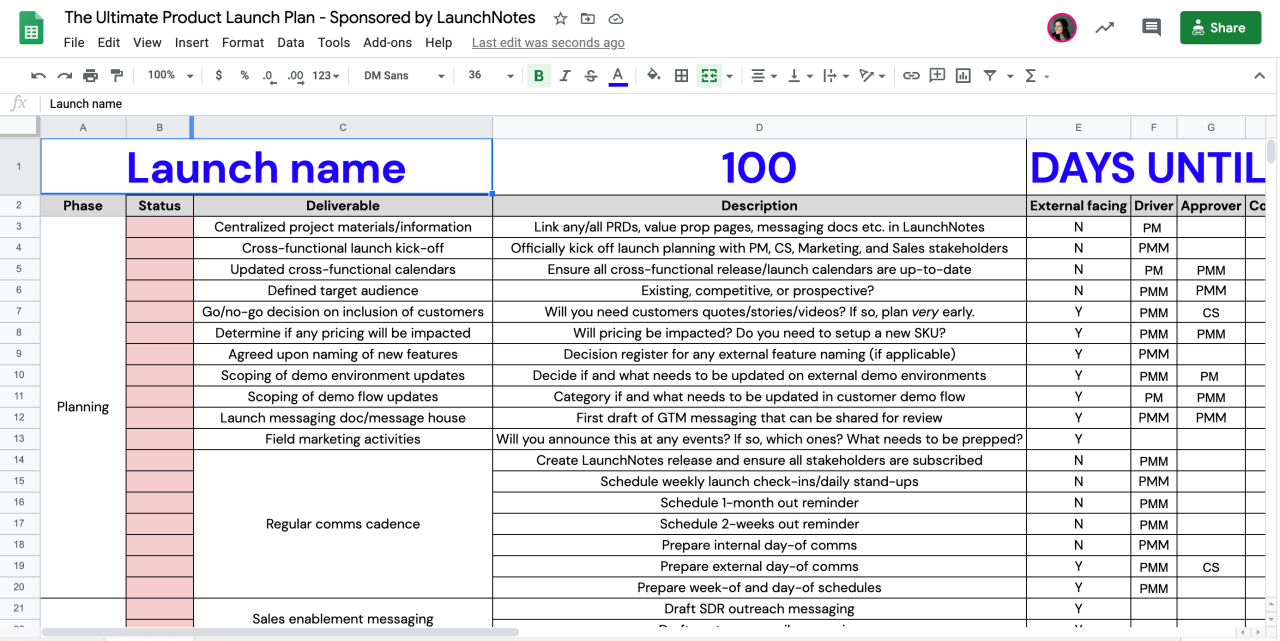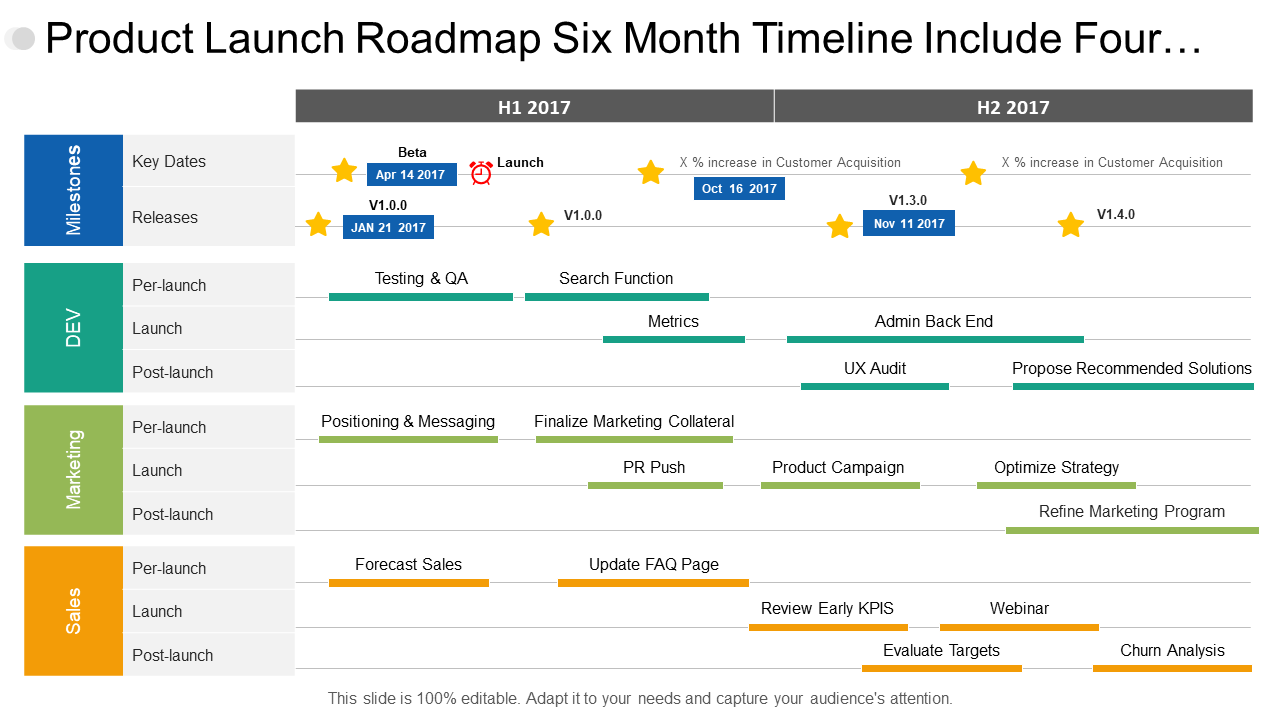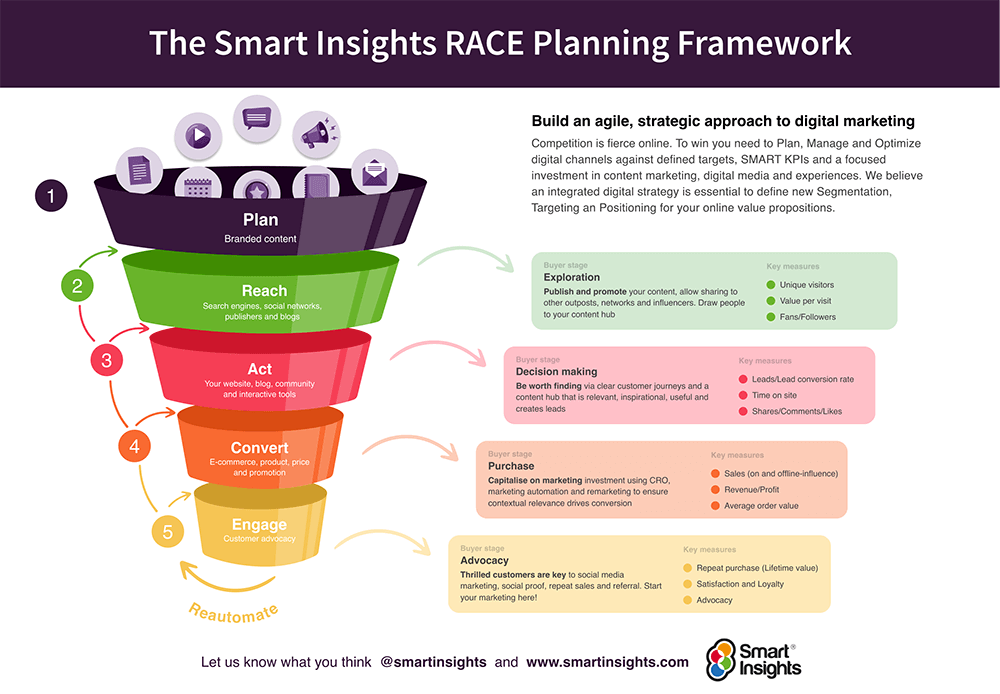Go-to-market strategy is the crucial roadmap guiding a product from conception to successful market penetration. This involves a detailed understanding of your target audience, a robust competitive analysis, and a well-defined marketing and sales approach. Successfully navigating these elements ensures efficient resource allocation and maximizes the chances of market dominance.
This guide delves into each stage, from meticulously defining your ideal customer and crafting unique value propositions to implementing a strategic marketing plan and developing a compelling sales process. We’ll explore various pricing models, crucial launch strategies, and methods for continuous improvement through data-driven iteration.
Defining Target Audience: Go-to-market Strategy

Defining our target audience is crucial for the success of our go-to-market strategy. A clearly defined target allows us to focus our marketing efforts and resources effectively, maximizing our return on investment. By understanding our ideal customer, we can tailor our messaging, product features, and sales approach for optimal impact.
Ideal Customer Persona: The “Busy Professional”
Our ideal customer is a busy professional, aged 30-50, holding a managerial or executive position in a medium-to-large sized company. They are tech-savvy, value efficiency and productivity, and are constantly seeking ways to streamline their workflows. They are likely to be digitally native and comfortable using various software applications. They are driven by results and prioritize solutions that demonstrably improve their team’s performance and their own efficiency. They are often involved in the decision-making process regarding software purchases for their teams and are therefore receptive to detailed information regarding ROI and value propositions. They typically work long hours and have limited time for extensive training or onboarding processes. This persona represents the core of our target market and informs all aspects of our marketing and sales strategies.
Key Differentiators of Target Audience
Three key characteristics differentiate our target audience from competitors’: Firstly, they are highly results-oriented, prioritizing measurable improvements in efficiency and productivity above all else. Secondly, they are comfortable with technology and actively seek innovative solutions to improve their workflow. Thirdly, they value time and require solutions that are easy to implement and integrate into their existing systems without requiring significant training or support. These characteristics allow us to focus our marketing messages on the tangible benefits and ease of use of our product, differentiating us from competitors who may focus on features or technical specifications.
Target Audience Segmentation
We will segment our target audience based on both demographics and behavior. Demographic segmentation will focus on company size, industry, and geographic location. Behavioral segmentation will focus on their specific pain points, such as managing project timelines, improving team communication, or streamlining data analysis. For example, one segment might be “Large Enterprise Project Managers” who struggle with managing complex projects across multiple teams and locations. Another segment could be “Small Business Owners” who need an efficient way to manage their teams and track their progress. A third segment might be “Marketing Managers” focused on optimizing campaign performance and ROI.
Product Solution for Each Segment
Our product solves specific problems for each segment. For “Large Enterprise Project Managers,” our product offers robust project management capabilities, real-time collaboration tools, and comprehensive reporting features to improve project visibility and control. For “Small Business Owners,” our product provides a simplified, user-friendly interface with intuitive tools for task management, communication, and team coordination. For “Marketing Managers,” our product offers data integration and analytical tools to measure campaign effectiveness, identify trends, and optimize marketing spend. Each segment will receive tailored marketing materials highlighting the features most relevant to their specific needs and challenges.
Competitive Analysis

Understanding the competitive landscape is crucial for a successful go-to-market strategy. This analysis compares our product, “Project Nova,” to three key competitors: “ChronoFlow,” “VelocityMax,” and “QuantumLeap,” highlighting their strengths, weaknesses, and how Project Nova will differentiate itself in the market.
Competitor Feature and Pricing Comparison
This section details the key features and pricing structures of Project Nova and its three main competitors. Direct comparison allows for a clear understanding of Project Nova’s competitive positioning.
| Feature | Project Nova | ChronoFlow | VelocityMax | QuantumLeap |
|---|---|---|---|---|
| Core Functionality | Advanced automation, real-time analytics, customizable dashboards | Basic automation, limited analytics, pre-set dashboards | Robust automation, comprehensive analytics, customizable dashboards | Advanced automation, limited analytics, pre-set dashboards |
| Integration Capabilities | Seamless integration with major CRM and ERP systems | Limited integration options | Good integration with popular systems | Limited integration, primarily with proprietary systems |
| Pricing (per month) | $99 (basic), $199 (premium), $499 (enterprise) | $79 (basic), $149 (premium) | $129 (basic), $249 (premium), $599 (enterprise) | $89 (basic), $179 (premium) |
Competitor Go-to-Market Strategy Analysis
This section analyzes the strengths and weaknesses of the go-to-market strategies employed by ChronoFlow, VelocityMax, and QuantumLeap. Understanding their approaches informs our strategic decisions.
ChronoFlow focuses on a low-cost, high-volume strategy, targeting small businesses with limited marketing spend. While effective for market penetration, this approach limits their ability to reach larger enterprises requiring more sophisticated solutions. VelocityMax employs a comprehensive marketing strategy incorporating content marketing, social media, and paid advertising, reaching a broader audience. However, their high pricing may limit accessibility for smaller businesses. QuantumLeap’s strategy relies heavily on direct sales and partnerships, focusing on enterprise clients. This approach requires significant upfront investment but offers higher margins.
A successful go-to-market strategy hinges on effectively guiding potential customers through the buying process. A key component of this is optimizing your e-commerce sales funnel, which is why understanding how to build a high-converting funnel is crucial. For insightful information on designing effective funnels, check out this resource on E-commerce sales funnels to better inform your overall go-to-market approach and boost your sales.
Project Nova’s Differentiation Strategy
Project Nova’s go-to-market strategy will differentiate the product through a combination of superior functionality, competitive pricing, and targeted marketing. We will leverage a multi-channel approach, combining online marketing with strategic partnerships to reach a wider audience while maintaining a focus on high-value enterprise clients.
Unique Value Propositions
Project Nova offers three key value propositions that set it apart from the competition:
- Unmatched Automation: Project Nova boasts the most advanced automation capabilities in the market, significantly reducing manual workload and improving efficiency.
- Real-time, Actionable Insights: Unlike competitors, Project Nova provides real-time analytics and customizable dashboards, empowering users to make data-driven decisions instantly.
- Flexible and Scalable Solutions: Project Nova offers a range of pricing tiers to accommodate businesses of all sizes, ensuring scalability and affordability.
Marketing Channels

Reaching our target audience requires a multi-pronged approach leveraging various marketing channels. This plan Artikels the channels we’ll utilize, their implementation timeline, budget allocation, and examples of successful campaigns using similar strategies. We will focus on a blend of organic and paid strategies to maximize reach and impact.
Marketing Plan Artikel
Our marketing strategy will utilize a combination of digital and potentially some traditional channels. This integrated approach allows us to reach our target audience across multiple touchpoints, fostering brand awareness and driving conversions. We’ll prioritize channels proven effective for reaching similar demographics and achieving comparable marketing goals.
Marketing Channel Timeline
The following timeline Artikels key milestones and deadlines for implementing our marketing plan. This schedule is designed to ensure a phased rollout, allowing for iterative adjustments based on performance data. We’ll track key performance indicators (KPIs) closely to optimize our campaigns over time.
| Milestone | Channel | Deadline | Responsible Party |
|---|---|---|---|
| Social Media Campaign Launch (Phase 1) | Instagram, Facebook | 2024-03-15 | Marketing Team |
| Content Marketing Strategy Implementation | Blog, Email Newsletter | 2024-04-01 | Content Marketing Manager |
| Paid Advertising Campaign Launch (Phase 1) | Google Ads, Social Media Ads | 2024-04-15 | Paid Media Specialist |
| Website Optimization and Implementation | Website | 2024-05-01 | Web Development Team |
| Social Media Campaign Launch (Phase 2) | TikTok, X (formerly Twitter) | 2024-06-01 | Marketing Team |
| Paid Advertising Campaign Launch (Phase 2) | Programmatic Advertising | 2024-06-15 | Paid Media Specialist |
Budget Allocation Strategy
Budget allocation will be dynamic, adjusting based on campaign performance. Initial allocation will prioritize channels with high potential for ROI, with ongoing adjustments based on data analysis. A contingency fund will be allocated to address unexpected opportunities or challenges.
| Channel | Initial Budget Allocation (%) | Rationale |
|---|---|---|
| Paid Social Media Advertising | 40% | High potential for targeted reach and conversion |
| Content Marketing (Blog, Email) | 30% | Builds brand authority and drives organic traffic |
| Search Engine Optimization () | 15% | Long-term strategy for sustainable organic growth |
| Paid Search Advertising (Google Ads) | 10% | Drives immediate traffic and conversions |
| Contingency | 5% | Addresses unexpected opportunities or challenges |
Examples of Successful Marketing Campaigns
The following table highlights successful marketing campaigns using similar channels for comparable products. These examples illustrate the potential for achieving significant results through strategic channel selection and campaign execution.
| Campaign Name | Channel | Budget (Example) | Results (Example) |
|---|---|---|---|
| Dove’s Real Beauty Campaign | Social Media, Television | $10 million (estimated) | Increased brand awareness and positive sentiment; drove significant sales growth |
| Old Spice’s “The Man Your Man Could Smell Like” Campaign | YouTube, Social Media | $3 million (estimated) | Viral success; massive increase in brand engagement and sales |
| Airbnb’s “Live There” Campaign | Social Media, Content Marketing | Undisclosed | Increased bookings and strengthened brand association with unique travel experiences |
Sales Strategy
A robust sales strategy is crucial for translating our go-to-market plan into tangible results. This section Artikels the sales process, team structure, training program, and successful sales strategies from comparable companies. A well-defined sales strategy ensures efficient lead conversion and sustainable revenue growth.
Sales Process
The sales process will be a structured, multi-stage approach designed to maximize conversion rates. It will incorporate lead generation through targeted marketing campaigns, meticulous lead qualification to identify high-potential prospects, and effective closing techniques that build rapport and address customer objections. The process will be tracked and analyzed regularly to identify areas for improvement.
Sales Team Structure and Responsibilities
Our sales team will consist of three distinct roles: Account Executives, Sales Development Representatives (SDRs), and a Sales Manager. Account Executives will manage existing accounts and focus on closing deals with qualified leads. SDRs will focus on lead generation and qualification, performing initial outreach and nurturing prospects. The Sales Manager will oversee the team, provide coaching and mentorship, and analyze sales performance data to identify opportunities for optimization. Each role has clearly defined Key Performance Indicators (KPIs) to track individual and team performance.
Sales Training Program
The sales training program will be comprehensive and ongoing, focusing on product knowledge, sales techniques, and customer relationship management (CRM) software proficiency. Initial training will cover product features, benefits, and target audience needs. Ongoing training will include workshops on effective communication, objection handling, and negotiation strategies. Regular performance reviews and coaching sessions will ensure continuous skill development.
Examples of Successful Sales Strategies
Several companies in our industry have demonstrated success with specific sales strategies. These examples provide valuable insights and can be adapted to our context.
- Company A: Employs a consultative sales approach, focusing on building strong relationships with clients and understanding their specific needs. Their success stems from providing tailored solutions rather than simply pushing products.
- Company B: Leverages content marketing and inbound sales techniques to attract qualified leads. They create valuable content (blog posts, webinars, ebooks) that attract potential customers and nurture them through the sales funnel.
- Company C: Successfully utilizes a multi-channel approach, combining online marketing (, social media) with traditional sales methods (phone calls, email outreach) to reach a wider audience and increase lead generation.
Pricing Strategy

Our pricing strategy for [Product Name] is a value-based model, focusing on delivering significant ROI to our customers. This approach recognizes the unique value proposition of our product and its ability to solve specific pain points for our target audience. We’ve carefully considered market research, competitive analysis, and our overall go-to-market strategy to determine the optimal pricing tiers.
Our pricing decisions are grounded in extensive market research that indicates a strong willingness to pay for a solution offering the level of efficiency and effectiveness provided by [Product Name]. The competitive landscape analysis revealed that while competitors offer similar solutions, none provide the same comprehensive feature set and ease of integration that we do. This allows us to justify a premium price point while maintaining a competitive edge.
Pricing Comparison with Competitors
The following table compares our pricing to three key competitors: Competitor A, Competitor B, and Competitor C. Each competitor offers a different pricing model, ranging from subscription-based to usage-based, reflecting their distinct value propositions and target markets. Our value-based pricing, while potentially higher than some competitors’ base plans, offers a more comprehensive feature set and superior customer support, ultimately delivering better value for money.
| Feature | [Product Name] | Competitor A | Competitor B | Competitor C |
|---|---|---|---|---|
| Basic Plan Price | $99/month | $49/month (limited features) | $79/month (limited integrations) | Free (with significant limitations) |
| Premium Plan Price | $199/month | $149/month | $129/month | $99/month (limited customer support) |
| Key Features Included | Full feature set, priority support, advanced analytics | Limited features, basic support | Limited integrations, average support | Basic features, limited support, slow response times |
| Target Customer | Businesses seeking high efficiency and ROI | Smaller businesses with limited budgets | Businesses requiring specific integrations | Users requiring a basic, free solution |
Alignment with Go-to-Market Strategy
Our value-based pricing strategy directly supports our overall go-to-market strategy. By focusing on delivering high value and superior customer support, we attract businesses willing to invest in a premium solution that delivers a strong return on investment. This approach aligns with our target market of businesses prioritizing efficiency and effectiveness, who are less price-sensitive and more focused on achieving tangible business outcomes. For example, a company that previously spent $5000/month on manual processes might see a reduction to $2000/month using [Product Name] at the $199/month premium plan, demonstrating a significant cost savings and return on investment. This clear value proposition is central to our marketing and sales efforts.
Product Launch Plan

A well-defined product launch plan is crucial for a successful market entry. It Artikels the strategic steps, timelines, and communication strategies necessary to generate excitement and drive adoption. A robust plan minimizes risks and maximizes the impact of the launch, ensuring a smooth transition from development to market.
Pre-Launch Activities, Go-to-market strategy
Pre-launch activities lay the groundwork for a successful product launch. These activities build anticipation and prepare the market for the product’s arrival. Thorough preparation during this phase is essential for a positive launch.
- Soft Launch/Beta Testing: Release the product to a select group of users for feedback and bug detection. This allows for iterative improvements before the full-scale launch. For example, Slack initially launched with a limited beta program, gathering valuable feedback that shaped its final product.
- Marketing & PR: Build anticipation through teaser campaigns, social media engagement, and press releases. Consider influencer marketing and content marketing to generate early buzz. The pre-launch phase of the iPhone 14 saw Apple strategically leak information and create anticipation through targeted social media campaigns.
- Sales Team Training: Equip the sales team with comprehensive product knowledge and sales materials. Role-playing and simulations can help them effectively address customer queries and close deals. A well-trained sales force is a cornerstone of a successful launch.
- Website and Landing Page Optimization: Ensure the website is optimized for search engines and user experience, with clear calls to action. A dedicated landing page showcasing the product’s key features and benefits should be prepared. This is vital for directing potential customers and converting them.
Launch Day Activities
Launch day is the culmination of all pre-launch efforts. The goal is to create a memorable experience and maximize initial sales and engagement.
- Official Product Announcement: Make a formal announcement across all chosen marketing channels, emphasizing the product’s key value proposition. A press release, social media posts, and email campaigns should be coordinated for maximum reach. Consider live streaming events to create buzz and engagement.
- Sales and Support Readiness: Ensure sales and support teams are prepared to handle a surge in inquiries and orders. Having sufficient inventory and efficient customer service processes in place is vital. Amazon’s launch of new products often involves significant logistical planning to meet high initial demand.
- Social Media Engagement: Actively monitor and engage with customers on social media platforms. Respond to comments, answer questions, and address any concerns promptly. Real-time interaction builds trust and fosters community.
- Promotional Offers and Incentives: Consider offering limited-time discounts, bundles, or early-bird bonuses to incentivize early adoption. This can drive initial sales and generate positive word-of-mouth marketing.
Post-Launch Activities
Post-launch activities focus on sustaining momentum, gathering customer feedback, and iterating on the product based on market response.
- Customer Feedback Collection: Actively solicit customer feedback through surveys, reviews, and social media monitoring. This feedback is invaluable for product improvement and future development. Companies like Spotify regularly use user feedback to shape their platform’s features and functionality.
- Performance Monitoring and Analysis: Track key metrics such as sales, website traffic, customer engagement, and customer satisfaction. Use data-driven insights to optimize marketing campaigns and product features. Google Analytics is a powerful tool for tracking website performance and user behavior.
- Product Iteration and Improvement: Based on post-launch data and feedback, make necessary improvements and updates to the product. Addressing customer concerns and incorporating new features can enhance user experience and drive continued growth. Software companies frequently release updates based on user feedback and bug reports.
- Ongoing Marketing and Promotion: Continue marketing and promotional efforts to maintain momentum and reach new customers. Develop long-term marketing strategies to build brand awareness and loyalty. Consistent engagement is crucial for sustained success.
Timeline and Communication Plan
A detailed timeline with key milestones and deadlines is essential for effective launch planning. This timeline should be shared across relevant teams to ensure coordinated efforts. A comprehensive communication plan will Artikel how the launch will be announced to the target audience, including messaging, channels, and timelines. For example, a successful communication plan might involve a phased approach, starting with a teaser campaign, followed by an official announcement, and then ongoing engagement with customers.
Final Summary
Developing a successful go-to-market strategy requires careful planning and execution. By thoroughly understanding your target audience, analyzing the competitive landscape, and implementing a well-defined marketing and sales strategy, you can significantly increase your chances of product success. Remember that continuous monitoring, analysis, and iterative adjustments based on performance data are key to long-term growth and market adaptation. This strategic approach ensures your product not only launches effectively but thrives in a dynamic market.
A successful go-to-market strategy hinges on understanding your target audience and offering a compelling value proposition. To achieve this effectively, staying abreast of the latest technological advancements is crucial; for example, you should regularly consult resources like this article on Update Teknologi Terbaru Untuk Startup to inform your approach. Ultimately, leveraging the right technology enhances your ability to reach your market and achieve your business goals with a well-defined go-to-market plan.